Digital Branding Strategies
How to Create a Compelling Brand Value Proposition: A Step-by-Step Guide
Overview
Crafting a compelling brand value proposition (BVP) is essential for establishing the unique advantages a brand presents to its customers. This differentiation is crucial for standing out from competitors and nurturing consumer loyalty. A well-defined BVP not only addresses customer needs and pain points but also aligns seamlessly with market trends and consumer expectations. Such alignment fosters trust and enhances engagement through clear communication and consistent brand messaging. By articulating these elements effectively, brands can reinforce their authority in the marketplace.
Introduction
In a world characterized by abundant consumer choices and fierce competition, the importance of a well-defined brand value proposition (BVP) is paramount. This essential marketing tool encapsulates the unique benefits a brand offers, directly addressing the critical question: “Why should customers choose this brand over others?” A robust BVP not only distinguishes a brand in a crowded marketplace but also cultivates deep emotional connections with consumers, fostering loyalty and influencing purchasing decisions. As brands navigate the complexities of modern consumer behavior, grasping the components and strategies behind an effective BVP becomes crucial for achieving sustainable success. Through compelling examples and actionable insights, this article explores the intricacies of crafting a BVP that resonates with target audiences, ultimately enhancing brand value and market presence.
Understanding Brand Value Proposition: Definition and Importance
A brand value proposition (BVP) is a concise statement that articulates the unique advantages and value an entity offers to its clients. It addresses the critical question: ‘Why should a client choose this brand over others?’ A well-crafted brand value proposition not only differentiates an organization from its competitors but also resonates with the needs and aspirations of its target audience.
The significance of a brand value proposition is underscored by its capacity to convey the essence of the company, thereby fostering loyalty and influencing purchasing decisions. Without a clearly defined brand value proposition, companies risk eroding their competitive edge in an increasingly crowded market.
Consider Apple, which exemplifies the strength of a compelling BVP through its focus on innovation and premium quality, appealing to tech-savvy consumers in search of cutting-edge products. This clarity in messaging cultivates a robust emotional connection with clients, increasing their likelihood of choosing Apple over alternative options.
Current statistics indicate that 94% of individuals exhibit loyalty towards companies that practice complete transparency, emphasizing the vital role of the brand value proposition in building trust. Furthermore, a survey reveals that 89% of consumers are inclined to purchase from companies they interact with on social media, showcasing the effectiveness of a persuasive brand value proposition in enhancing sales and engagement.
The impact of a well-defined brand value proposition extends to consumer loyalty, with studies demonstrating that companies with strong offerings experience elevated retention rates. For instance, implementing rewards programs can significantly enhance client appreciation and loyalty, highlighting the critical importance of the brand value proposition in cultivating lasting relationships.
Successful examples of brand offerings include companies like Nike, which inspires through its ‘Just Do It’ mantra, motivating consumers to chase their athletic goals. Such powerful concepts resonate deeply with customers, fostering both loyalty and sales.
In conclusion, the importance of a company’s value in 2025 cannot be overstated. It serves as a foundational element in marketing strategies, influencing the brand value proposition, consumer decision-making, and loyalty. As branding expert Josh Howarth aptly stated, ‘It takes many good deeds to build a reputation, and only one bad one to lose it,’ highlighting the necessity of a robust brand value proposition in maintaining a positive image.
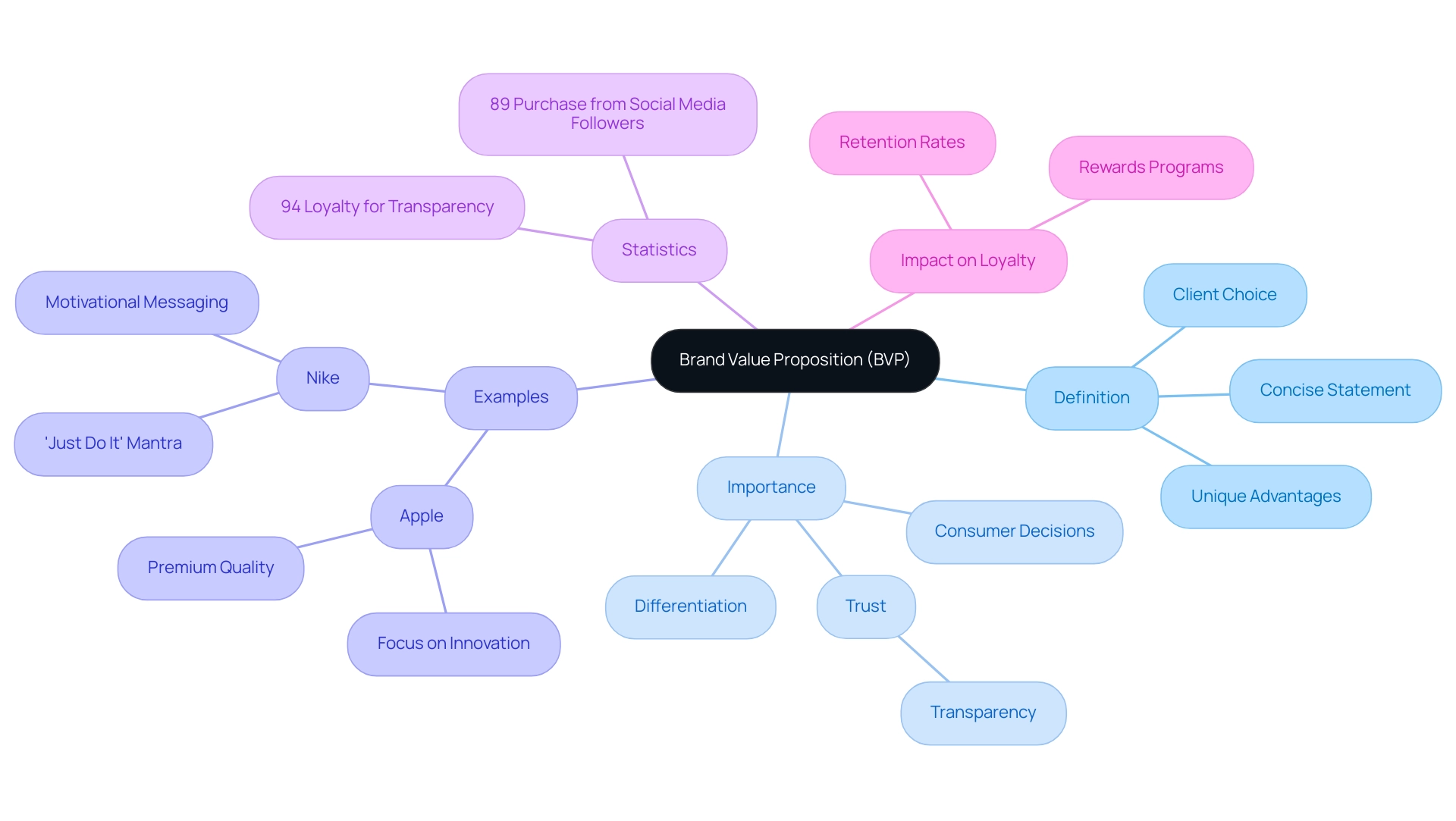
Key Components of an Effective Brand Value Proposition
An effective brand value proposition (BVP) is essential for establishing a strong connection with your target audience and typically encompasses several key components:
-
Target Audience: Clearly defining your ideal customers is paramount. Understanding their demographics, preferences, and pain points allows companies like WonderEight to tailor their messaging effectively. In 2025, marketers are increasingly focusing on content marketing, with 93% of internet users active on social media, underscoring the importance of knowing where your audience engages. Additionally, with 62% of advertising in the past year being online, the significance of digital marketing in establishing a brand value proposition cannot be overstated.
-
Problem Statement: Identifying the specific problems or needs your company addresses positions it as a solution provider. This clarity not only aids in crafting targeted messaging but also resonates with consumers who are seeking answers to their challenges.
-
Unique Selling Proposition (USP): Your USP is what sets your company apart from competitors. This could be a unique feature, superior quality, or exceptional customer service. For example, companies like Castania have successfully leveraged their unique offerings to enhance their market presence, demonstrating the power of a well-defined USP. As Bryan Philips from In Motion Marketing states, “We turn B2B marketing challenges into growth opportunities,” emphasizing the need for companies to articulate their unique value effectively.
-
Benefits: Articulating both tangible and intangible benefits is crucial. Customers should recognize how your company enhances their lives or addresses their issues. This could range from enhanced performance, as seen in Nike’s emphasis on innovation and technology, to emotional benefits like loyalty and community engagement.
-
Proof: Providing evidence to support your claims strengthens your BVP. This can include testimonials, case studies, or statistics that demonstrate your company’s effectiveness. For instance, LinkedIn’s statistics reveal that it has over 1 billion members, making it an ideal platform for B2B marketing and thought leadership. Brands targeting young professionals should prioritize high-quality content and industry insights to effectively engage with the LinkedIn audience, showcasing WonderEight’s credibility.
By combining these elements, companies like WonderEight can establish a strong brand value proposition that not only draws in but also retains customers, ultimately promoting business expansion and visibility in a competitive environment.
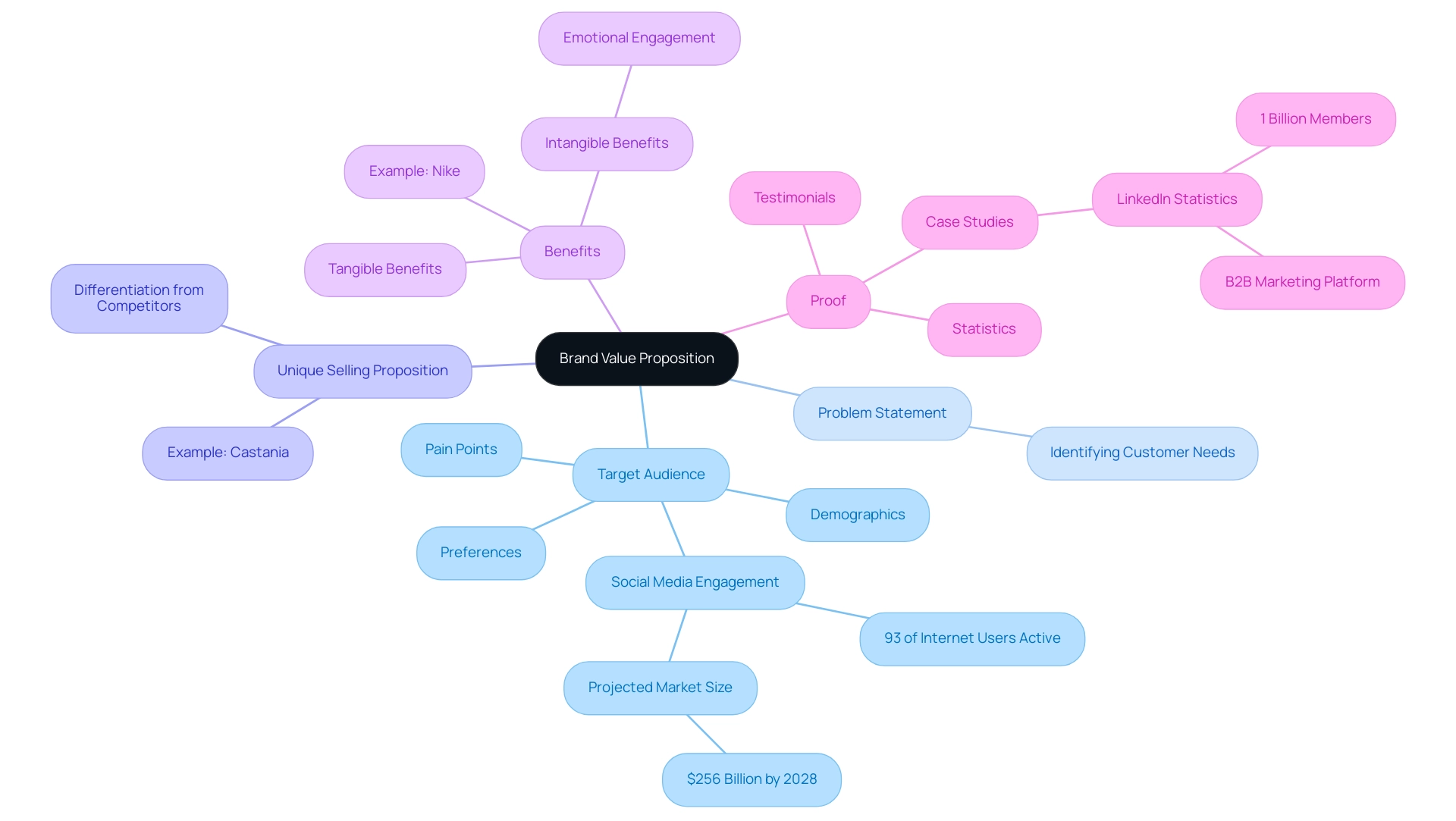
Step-by-Step Process to Craft Your Brand Value Proposition
To craft a compelling brand value proposition (BVP) with WonderEight, consider these essential steps:
- Conduct Market Research: Begin by gathering insights about your target audience. Understand their needs, preferences, and pain points through various methods such as surveys, interviews, and competitor analysis. In 2025, a significant shift in marketing budgets indicates that companies are increasingly investing in content creation and market research, with 26% of marketers planning to increase their investment in platforms like Facebook. This underscores the critical importance of understanding consumer behavior.
- Define Your Unique Value: Identify what sets your label apart from competitors. Focus on your strengths, unique features, and the specific benefits you provide. This clarity is crucial, as 75% of consumers are likely to sever ties with companies that experience a cyber incident, emphasizing the need for a strong and trustworthy identity.
- Articulate the Problem: Clearly express the issue your company addresses for clients. This establishes your identity as a solution provider, facilitating potential clients to recognize the benefits you offer.
- Draft Your Brand Value Proposition: Synthesize the insights from the previous steps into a concise statement that effectively communicates your unique value and benefits. Aim for clarity and simplicity to ensure your message resonates.
- Test and Refine: Share your BVP with a sample of your target audience to gather feedback. Use this input to refine your statement, ensuring it aligns with customer expectations and resonates with their needs. As Stephanie Rand, Senior Customer Research Manager, notes, “While quantitative data gives you the big picture facts and figures, qualitative research digs into the human details.”
For instance, a startup in the health food sector might discover through research that their target audience prioritizes convenience and health. Consequently, their brand value proposition could emphasize providing quick, nutritious meal options tailored for busy lifestyles. This approach not only highlights the unique offerings but also addresses the specific needs of their audience, enhancing overall recognition and loyalty.
Furthermore, with the increasing confidence in applying AI to market research, as indicated by the 83% of professionals planning to invest in AI for their research activities, companies can leverage these tools to refine their BVP effectively. This connection to current trends highlights the significance of WonderEight’s abilities in creating customized branding strategies that resonate with target audiences, showcasing our innovative methodologies and success stories in enhancing identity and market presence.
The Interconnection Between Brand Value and Brand Proposition
The worth of a label and its offering are fundamentally interconnected. The worth of a label, or its brand value proposition, reflects the perceived significance of a label from the consumers’ perspective, influenced by factors such as reputation, quality, and client experience. Conversely, the company’s unique selling statement articulates the distinct advantages that an entity provides to its clients, serving as a crucial touchpoint in the consumer decision-making process.
An engaging unique selling statement significantly enhances the brand value proposition by effectively conveying the essence of what the entity represents and its relevance to consumers. For instance, Coca-Cola’s market appeal centers around themes of joy and unity, reinforcing its position as a leader in the beverage sector. This strategic alignment between company worth and offering not only cultivates consumer trust but also fosters loyalty, making clients more inclined to choose Coca-Cola over its competitors.
Current data underscores the importance of company worth offerings in shaping consumer trust; nearly 70% of individuals report feeling a stronger connection with a brand when its CEO is active on social media. This highlights the critical role of leadership in shaping perception and enhancing consumer relationships, demonstrating how a strong identity offering can be supported by visible and engaged leadership.
Moreover, data indicates that 80% of consumers frequently purchase name-label products, suggesting that a clearly defined identity offering can significantly influence buying behavior. As companies aim to resonate with socially conscious consumers, aligning their brand value proposition with broader societal values becomes essential, as 70% of global consumers feel a responsibility to purchase products that are environmentally and socially beneficial.
The significance of consistency in marketing cannot be overstated; a strong brand value proposition contributes to a recognizable identity that resonates with customers and reflects business values across various channels. This consistency is vital for maintaining a positive reputation, as emphasized by Josh Howarth’s quote: ‘It takes many good deeds to build a reputation, and only one bad one to lose it.’
Additionally, the case study of WonderEight’s comprehensive campaign for Quaker Oats illustrates the practical application of branding strategies. The campaign showcased innovative design and technology, resulting in enhanced engagement and a stronger market position for Quaker Oats. WonderEight’s approach demonstrates how integrating digital marketing solutions with identity strategies can elevate overall recognition and market presence.
In summary, the connection between worth and the brand value proposition is paramount for shaping a company’s identity and nurturing consumer loyalty. By developing a robust identity offering, companies can enhance their reputation, ultimately leading to greater market presence and consumer confidence.
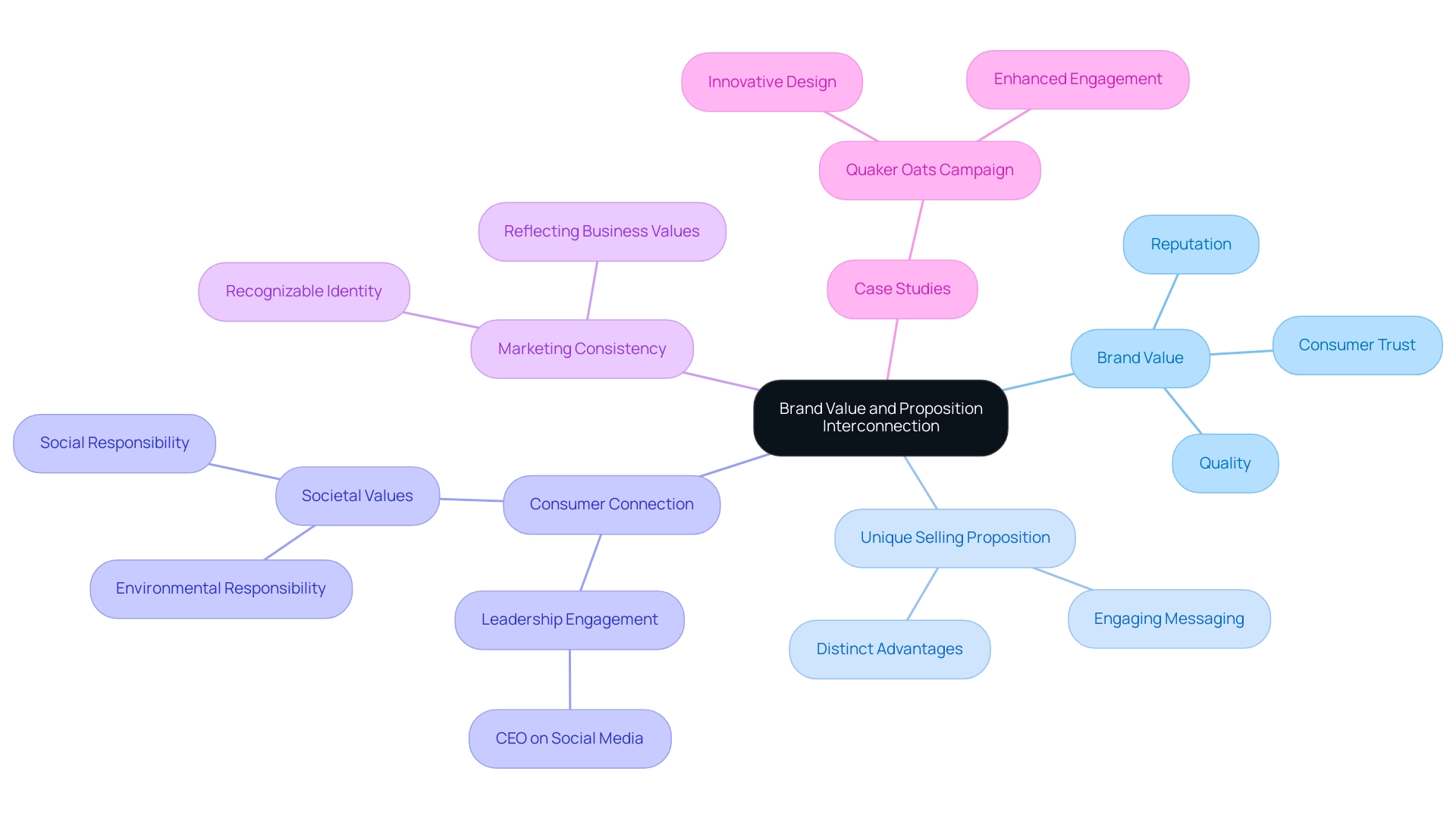
Leveraging Brand Value Proposition for Competitive Advantage
To effectively utilize your brand value proposition (BVP) for competitive advantage, consider implementing the following strategies:
- Communicate Clearly: Your BVP should be prominently displayed across all marketing channels, including your website, social media platforms, and advertising campaigns. Clear communication is essential for ensuring that potential clients grasp your unique value. In fact, 73% of consumers make purchasing decisions based on a product’s or service’s visual appeal, highlighting the significance of strong visual design in branding (The Design Council). At WonderEight, we specialize in crafting comprehensive communication strategies that enhance your brand’s visibility across all platforms.
- Align with Client Needs: Regularly assess and adapt your brand value proposition to stay in tune with evolving client requirements and market trends. A study indicates that 88% of clients place importance on authenticity in branding efforts, which can assist in retaining clients and building trust. This proactive approach not only enhances relevance but also strengthens your competitive edge. Our digital audits at WonderEight can help identify gaps and opportunities in your current strategy, ensuring alignment with client expectations. Additionally, our SEO consultancy services can optimize your online presence to better meet client needs. Utilize storytelling to showcase how your brand value proposition translates into tangible benefits. Sharing client success stories and testimonials can effectively highlight the positive impact of your products or services, fostering a deeper connection with your audience. WonderEight’s expertise in content creation can help you craft compelling narratives that resonate with your target market.
- Differentiate Through Experience: Strive to create exceptional client experiences that reinforce your BVP. This could involve personalized service, loyalty programs, or community engagement initiatives that resonate with your target market. Utilizing analytics tools, such as those offered by WonderEight, can help measure the effectiveness of displayed content and audience engagement, ensuring your strategies are impactful. Furthermore, our website and app design and development services can enhance user experience, making your company more appealing.
For instance, Tesla exemplifies the effective use of its brand value proposition, which is centered on sustainability and innovation, positioning itself as a frontrunner in the electric vehicle sector. This approach not only attracts eco-aware customers but also strengthens Tesla’s competitive edge in a swiftly changing market.
Integrating these tactics can greatly improve your company’s visibility and effectiveness in conveying its worth, ultimately fostering customer loyalty and involvement. With WonderEight’s integrated marketing solutions, including social media strategy, e-commerce development, and comprehensive digital audits, you can elevate your identity to new heights. Contact us today to learn how we can help you achieve your branding goals.
Case Studies: Successful Brand Value Propositions in Action
Analyzing successful product offerings provides essential insights into effective marketing strategies, particularly in the realm of digital transformation. Notable examples illustrate the power of a well-crafted brand value proposition (BVP):
- Airbnb: The brand value proposition focuses on providing unique travel experiences and fostering local connections. This approach appeals to travelers seeking authenticity, allowing the company to disrupt the traditional hospitality industry significantly. By emphasizing the personal touch and local culture, Airbnb has crafted its BVP to be more than just a booking platform; it has become a facilitator of memorable experiences.
- Slack: Its brand value proposition emphasizes enhancing collaboration and productivity within teams. By positioning itself as a tool that streamlines communication, Slack has rapidly gained traction among businesses. This evident offering not only meets the demand for effective collaboration but also integrates seamlessly with other tools, rendering it essential in contemporary workplaces.
- Dollar Shave Club: With a brand value proposition focused on delivering affordable, high-quality razors directly to consumers, Dollar Shave Club disrupted the shaving industry. By addressing the common pain point of overpriced razors, the company quickly cultivated a loyal customer base. Their innovative subscription model and engaging marketing campaigns further solidified their market presence.
- Cadbury’s Favourites: This product is marketed as a convenient gift option, positioning it as a substitute for traditional gifts like flowers or wine. This unique positioning has allowed Cadbury to tap into the gifting market, emphasizing the social aspect of chocolate consumption and showcasing the effectiveness of its brand value proposition.
These examples underscore the significance of a clear brand value proposition in connecting with target audiences and promoting business growth. As noted by Chantel Hall, “While it might be tempting only to write case studies about the biggest, flashiest projects, you should create a bank of case studies that speak to the unique groups included in your target audience.” This highlights the need for diversity in case studies to connect with various audience segments.
Statistics reveal that 66% of buyers prefer to share business-related content through email, reinforcing the importance of clear messaging in the brand value proposition. By learning from these successful case studies, companies can improve their own offerings to enhance market impact and foster deeper connections with their audiences.
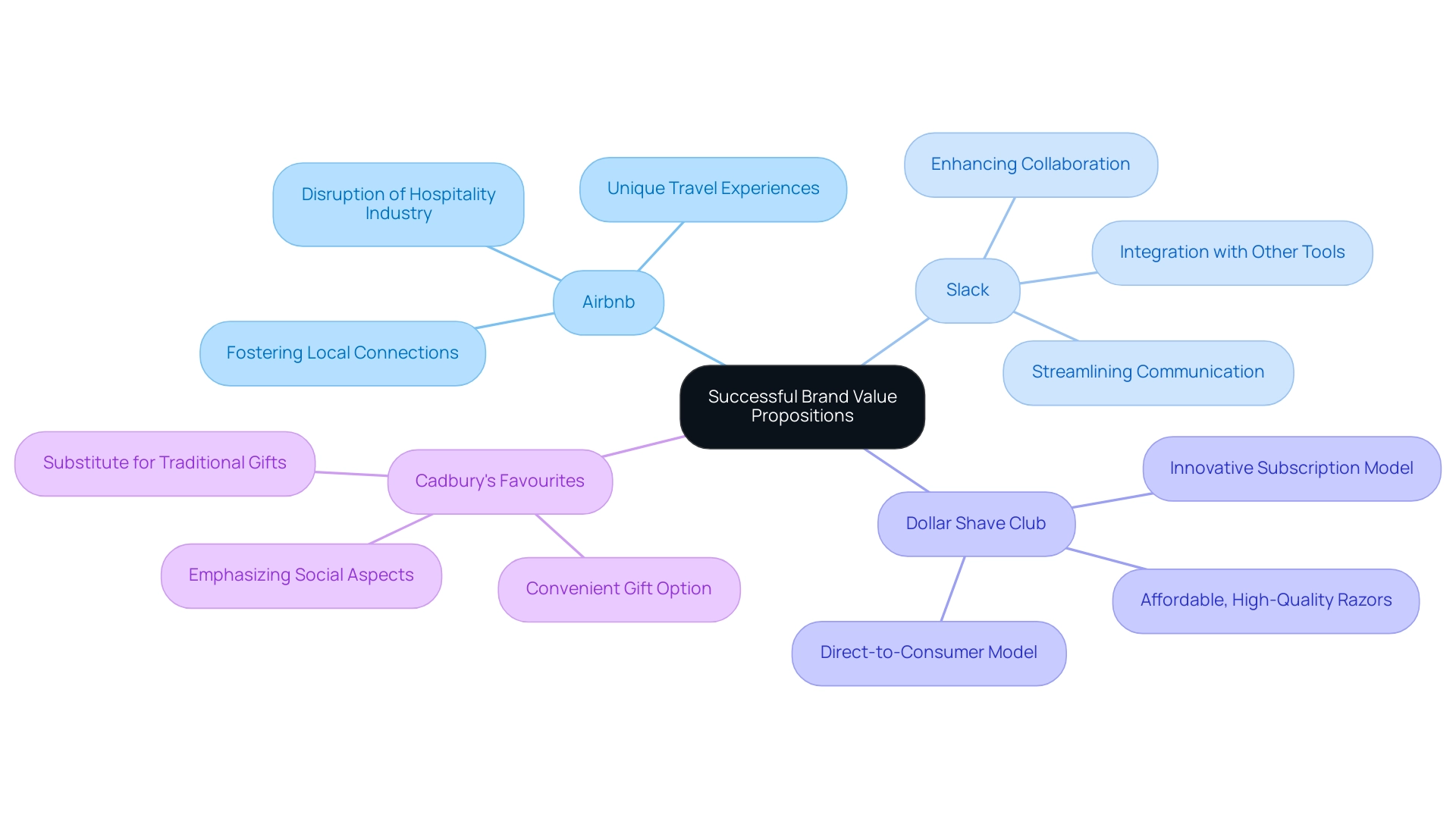
Evolving Your Brand Value Proposition: Best Practices and Key Takeaways
To ensure your brand value proposition (BVP) remains effective and resonates with your audience, it is imperative to implement the following best practices:
-
Regularly Review and Update: Successful companies consistently assess their BVP. Studies indicate that those who do so are more likely to align with evolving market trends and client expectations. This adaptability is crucial for maintaining relevance in a competitive landscape. Notably, only 29% of low-income consumers trust their labels, compared to 38% of high-income shoppers. This statistic highlights the importance of trust in fostering loyalty.
-
Collect Client Insights: Actively pursuing client feedback is essential for understanding perceptions of your image and its value proposition. Research shows that companies emphasizing consumer insights can make informed modifications that enhance their appeal. As Sarah Lee states, “Understanding these challenges is the first step in designing research methods that accurately capture customer loyalty.” Implementing effective feedback mechanisms can significantly enhance customer loyalty and recognition.
-
Monitor Competitors: Vigilantly observing competitors’ offerings and market positioning is vital. This awareness not only helps identify opportunities for differentiation but also informs strategic adjustments to your brand value proposition, ensuring it stands out in the marketplace. Furthermore, budget limitations impact 62% of demand-gen marketers, with 58% noting a shortage of internal resources. This emphasizes the necessity for companies to be agile and responsive in their BVP strategies.
-
Stay True to Your Identity: While evolving your BVP is important, maintaining authenticity to your core principles and mission is essential. Consistency fosters trust with your audience, a critical component of long-term loyalty. The gap in training programs, as highlighted in the case study on skills training needs in marketing, illustrates that many marketers feel unprepared to adapt their strategies in an evolving industry.
By adhering to these practices, brands can cultivate a dynamic brand value proposition that not only attracts customers but also nurtures enduring loyalty, ultimately driving business success.
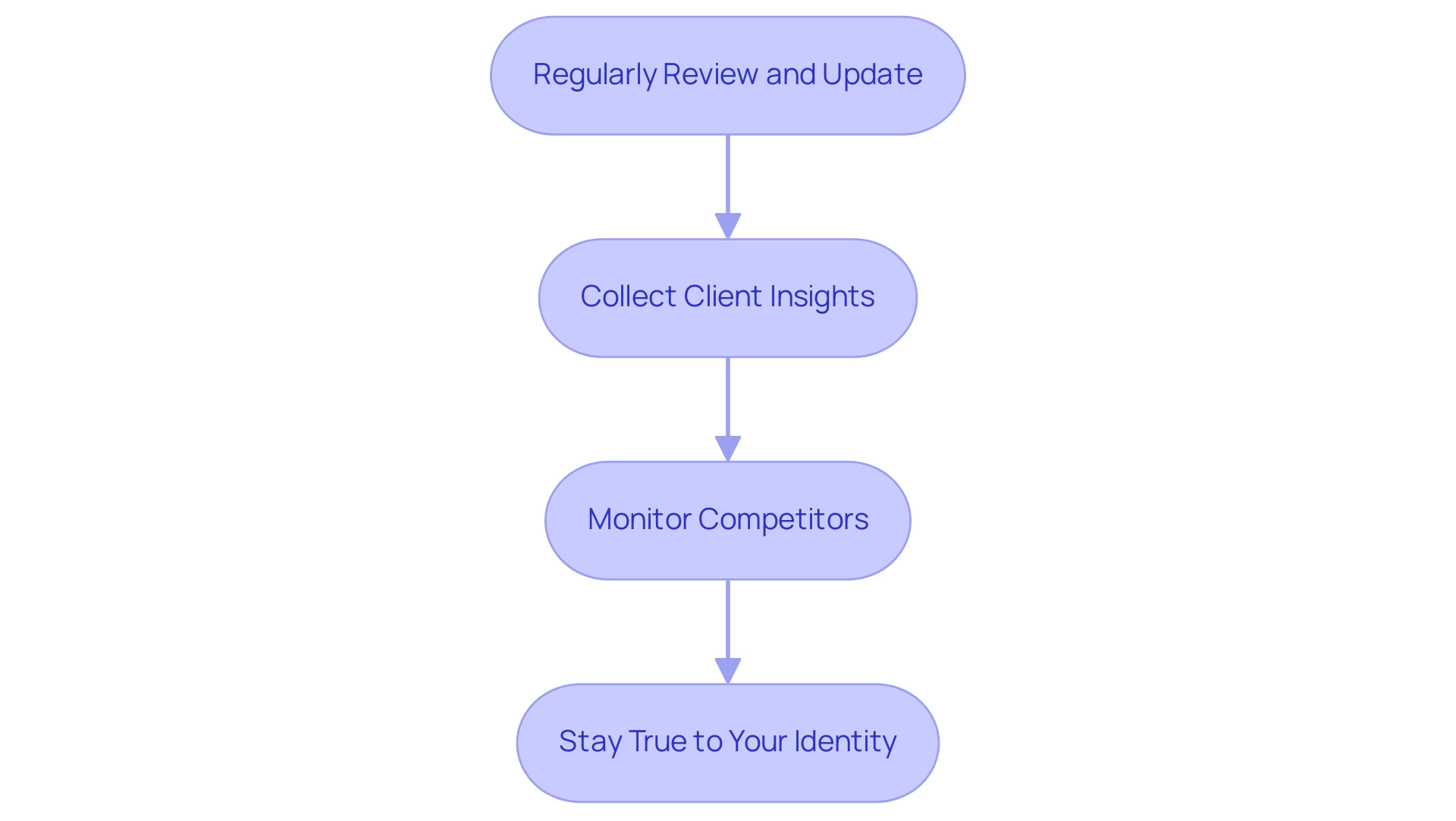
Conclusion
A well-defined brand value proposition (BVP) is essential for any brand aiming to carve out a unique space in a crowded marketplace. It encapsulates the unique benefits a brand offers, addressing why customers should choose one brand over another. The significance of a strong BVP is underscored by its ability to foster customer loyalty, influence purchasing decisions, and build trust through transparency and authenticity.
Key components of an effective BVP include:
- A clear understanding of the target audience
- A defined problem statement
- A unique selling proposition
- Articulated benefits
- Proof to support claims
These elements work together to create a compelling narrative that resonates with consumers, as illustrated by successful brands like Apple, Nike, and Airbnb. Moreover, the interplay between brand value and brand proposition highlights the necessity of consistency in messaging and experience, reinforcing brand identity and consumer trust.
To maintain relevance and adaptability, brands must regularly review and evolve their BVP. Gathering customer feedback and monitoring competitors are crucial for staying ahead in a dynamic market. By prioritizing authenticity and aligning with customer needs, brands can not only attract new customers but also cultivate long-term loyalty, ultimately driving business success.
In conclusion, a robust brand value proposition is not merely a marketing tool; it is the foundation of a brand’s identity and a key driver of its success in a competitive landscape. As businesses navigate the complexities of consumer behavior and market trends, crafting and refining a compelling BVP will remain vital for achieving sustainable growth and cultivating meaningful connections with customers.
Frequently Asked Questions
What is a brand value proposition (BVP)?
A brand value proposition (BVP) is a concise statement that articulates the unique advantages and value an entity offers to its clients, answering the question: “Why should a client choose this brand over others?”
Why is a brand value proposition important?
A well-crafted BVP differentiates an organization from its competitors, resonates with the target audience’s needs, fosters loyalty, and influences purchasing decisions. Without it, companies risk losing their competitive edge in a crowded market.
Can you provide an example of a strong brand value proposition?
Apple exemplifies a strong BVP through its focus on innovation and premium quality, appealing to tech-savvy consumers seeking cutting-edge products, which cultivates a robust emotional connection with clients.
How does consumer loyalty relate to brand value propositions?
Studies show that companies with strong BVPs experience elevated retention rates. For instance, implementing rewards programs can significantly enhance client appreciation and loyalty, highlighting the importance of a BVP in building lasting relationships.
What statistics indicate the effectiveness of brand value propositions?
Current statistics indicate that 94% of individuals exhibit loyalty toward companies that practice complete transparency, and 89% of consumers are inclined to purchase from companies they interact with on social media.
What key components make up an effective brand value proposition?
The key components include: 1. Target Audience: Understanding demographics and preferences. 2. Problem Statement: Identifying specific problems the company addresses. 3. Unique Selling Proposition (USP): What sets the company apart from competitors. 4. Benefits: Articulating tangible and intangible benefits for customers. 5. Proof: Providing evidence to support claims, like testimonials or statistics.
How can companies leverage their unique selling proposition (USP)?
Companies can enhance their market presence by clearly articulating their USP, such as unique features, superior quality, or exceptional customer service, which differentiates them from competitors.
What role does digital marketing play in establishing a brand value proposition?
With 62% of advertising being online in the past year, digital marketing is crucial for establishing a brand value proposition, especially as 93% of internet users are active on social media.



